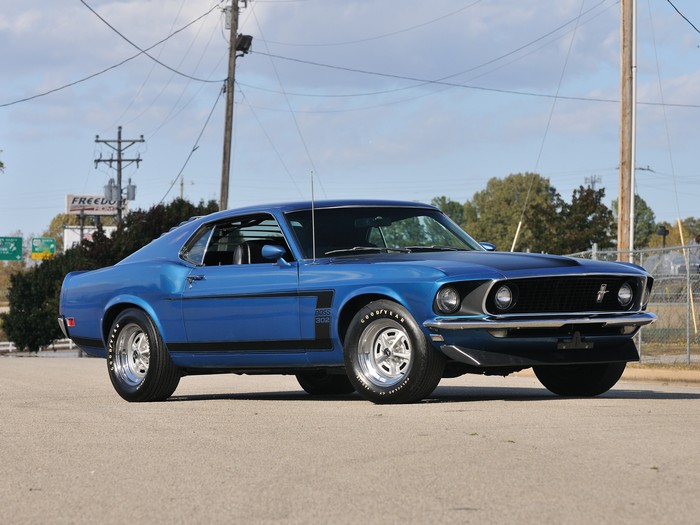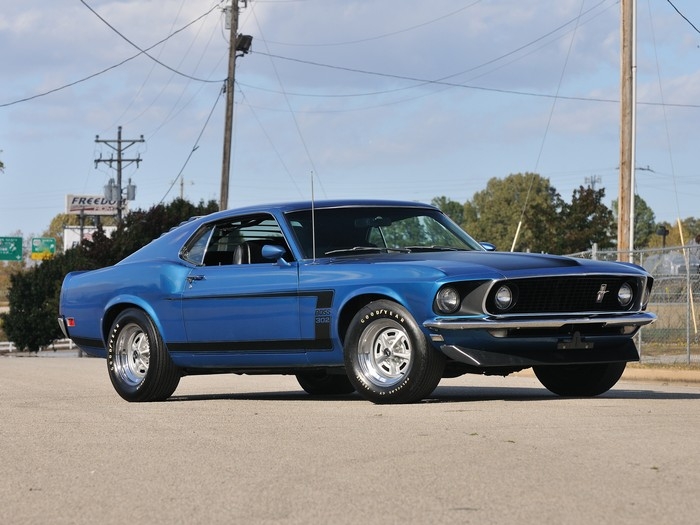
• Believed to be 17,000 actual miles
• Boss 302 matching-numbers engine
• 4-speed transmission, 3.50 Posi rear end
• Documented by the invoice, Protect-O-Plate, warranty card, Elite Marti Report, original drive-out tag, metal dealership tag
• Acapulco Blue with black interior
• Power steering and brakes
• Argent Gray Magnum wheels, rear window louvers
• F-60-15 Goodyear polyglas raised white-lettertires
• All components still intact, smog system, blow-up spare tire, shifter and ball, console, mostly original paint, interior, chrome and stainless
• Last tagged in 1982, Boss 302 registry report
• Late-built car July 1969 and sold new in September 1969, making it one of the last ’69 Boss 302s built
SCM Analysis
Detailing
| Vehicle: | 1969 Ford Mustang Boss 302 |
| Years Produced: | 1969–70 |
| Number Produced: | 8,641 (1,628 in 1969, 7,013 in 1970) |
| Original List Price: | $3,720 |
| SCM Valuation: | $32,000–$54,000 |
| Tune Up Cost: | $200 |
| Distributor Caps: | $25 |
| Chassis Number Location: | Driver’s side dash, visible through the windshield |
| Engine Number Location: | Stamped inside of engine block behind starter motor; also on a tag affixed to the coil mounting bolt, which is usually missing |
| Club Info: | Mustang Club of America |
| Website: | www.mustang.org |
| Alternatives: | 1970 Plymouth AAR ’Cuda, 1970 Dodge Challenger T/A, 1969 Chevrolet Camaro Z/28 |
| Investment Grade: | A |
This Boss 302, Lot S131, sold for $71,020 including buyer’s premium, at the Mecum Kissimmee sale on January 26, 2013 in Kissimmee, FL. It was an unrestored car with exceptionally low miles, fully documented with day-one paperwork and finished in a desirable color. Most of the original paint was intact, as was most of the original equipment.
Let’s drive right into this. The muscle-car crowd knows these cars — you simply can’t ignore them. Odds are, if you don’t have one parked in your garage, you’d like to.
Trans Am on the street
The Big Three all came out to play for the Trans Am racing series in the late 1960s — GM with the Camaro Z/28, Chrysler with the Challenger T/A and AAR ’Cuda and, finally, our subject car, the 1969–70 Ford Mustang Boss 302. Trans Am homologation rules at the time required that track cars be based on production cars offered for sale to the general public.
In short, that meant that a manufacturer couldn’t stack the deck with a car produced solely for racing — something that would simply cost too much for the average automotive enthusiast, or be too hard to use on the street (although some guys wouldn’t mind strapping into a race harness for their drive to work). Further, homologation meant that a minimum sales level had to be met to consider the Boss as a street production vehicle.
GM to the rescue?
Ford ruled its classes in Trans Am in ’66 and ’67 with the Mustang, but rivals Chevrolet took the crown in ’68 and ’69 with the Z/28. The ’69 Boss 302 was Ford’s no-expense-spared attempt at regaining control of the winner’s circle. And in 1970, they did just that.
The Boss was designed by Larry Shinoda, a former GM employee. As the story goes, Shinoda, who also wheeled his magical design pen with the 1963 and 1968 Corvette, code-named the project “Boss” with respect to the new Ford top dog, Bunkie Knudsen. Knudsen had recruited Shinoda from GM and tapped him for the sole task of designing the purpose-built Mustang.
The 1969 redesign of the Mustang was a welcome departure from the 1968 model. The car was in the beginning throes of becoming stale and somewhat predictable. The all-new-for-1969 Sportsroof model (aka the fastback) looked fast standing still.
And in Boss 302 trim, they were fast. Power was provided by a Ford Windsor block mashed up to heavy-breathing Cleveland heads. A solid-lifter cam offered higher revs, and the resulting package tossed out 290 hp from 302 cubic inches. Not bad for a small-block production car that was just about ready for track duty with only minor modifications. On the handling side, larger sway bars and heavier suspensions came into play, and a 4-speed transmission with a Hurst shifter came standard.
Production for the 1969 Boss 302 was 1,628 units. In 1970, production rose dramatically to 7,013, which makes our subject car a lot more desirable given tin-worm attrition and, well, telephone poles.
Twists and turns in the market
The Boss 302 market hasn’t been immune to the twists and turns from an investment standpoint. Lesser cars, meaning those without great documentation, original equipment and questionable backgrounds, can be found in the low-to-high $40k range. Like any muscle car, it all comes down to condition and overall appeal. Add a shaker hood and you’ll find a higher score on the appeal-o-meter, which can kick up the value respectably.
Mecum’s Kissimmee sale was big — really big. Four Boss 302s were up for grabs: two 1969s and two 1970s. A yellow 1969 that was reported to be unrestored sold for $42,400, while a 1970 concours-restored trailer queen found $121,900.
Our subject car tipped the scales at $71,020 — not in the middle of the pack, but not all that far away from the middle, either. By the books, the number is right in the proper range for a well-sorted Boss 302.
An unrestored deal
There are more than a few comparable Boss 302s in the ACC database. First up, ACC# 213779, a desirable Grabber Blue 1970 example, which sold for $77,000. This is a great comp, as it only had 5,418 original miles and was reported to be in fine condition. Second, ACC# 214154, another ’70 Grabber Blue model, which stayed with the seller against a high bid of $75,000. There’s also ACC# 209043, a bright yellow ’70 example reported to be in stunning condition, selling for $106,700. Given that condition affects the value in a significant way, all three cars found proper bids based on the summary reports — and the current market.
Our subject car was unrestored but reported to be in very good condition. This is a distinctive notation, as unrestored cars can be shabby on occasion and will ultimately turn off some buyers who yearn for a minty-fresh example. This car looked great, but I’m certain it’ll fall flat when stacked up next to a nut-and-bolt restored example. After all, this car is now 44 years old. Added use that deteriorates the car’s condition will cost the owner money.
Then again, cars like this are only original once, and a lot of today’s buyers are now seeing substantial value in that originality. So from a collecting and investment standpoint, this car was a home-run offering — the Mecum auction description was right in calling it “a true dream machine for the Boss Mustang enthusiast.”
Given the presentation, documentation, rarity and glorious unrestored condition, I’d give this car a huge attaboy along with a tip of the ol’ ball cap to the buyer. Well bought.
(Introductory description courtesy of Mecum Auctions.)
